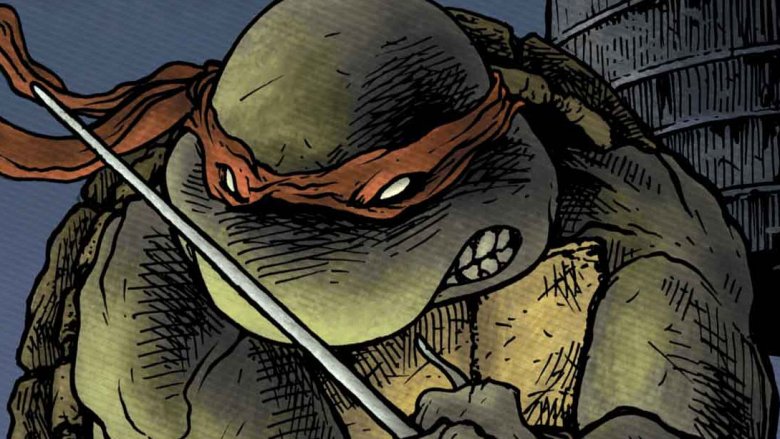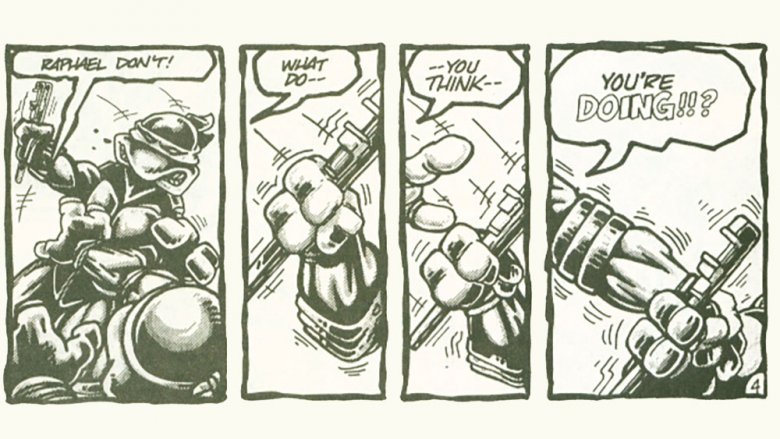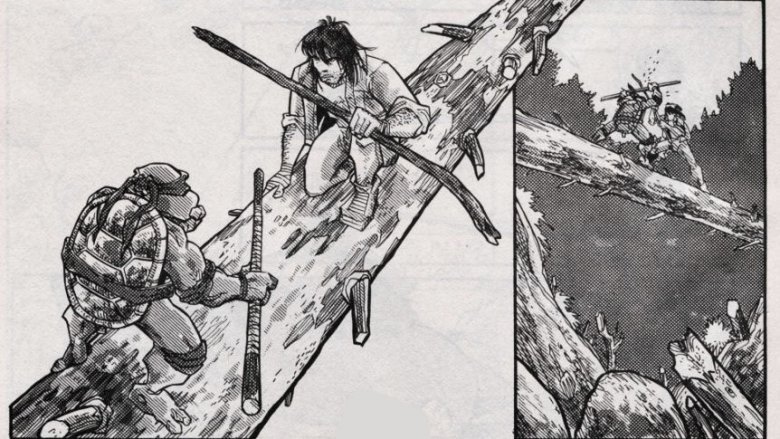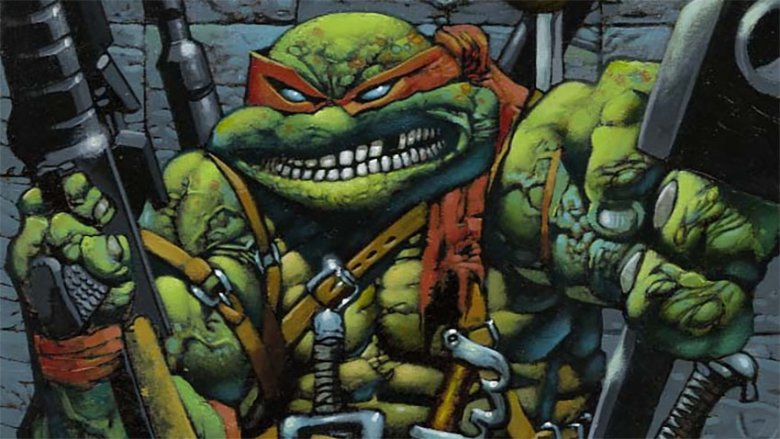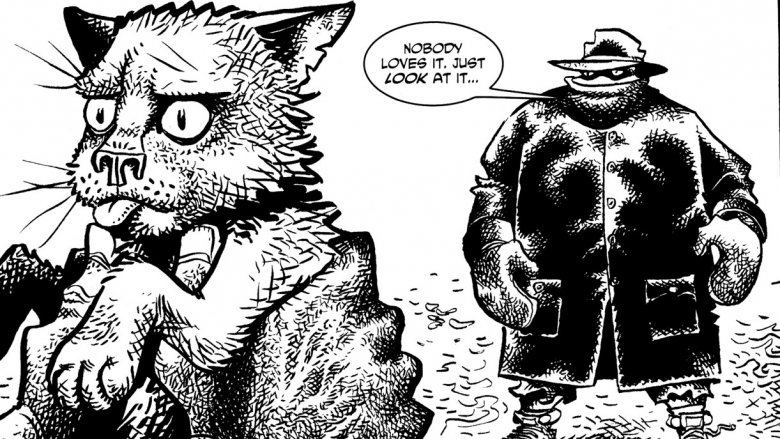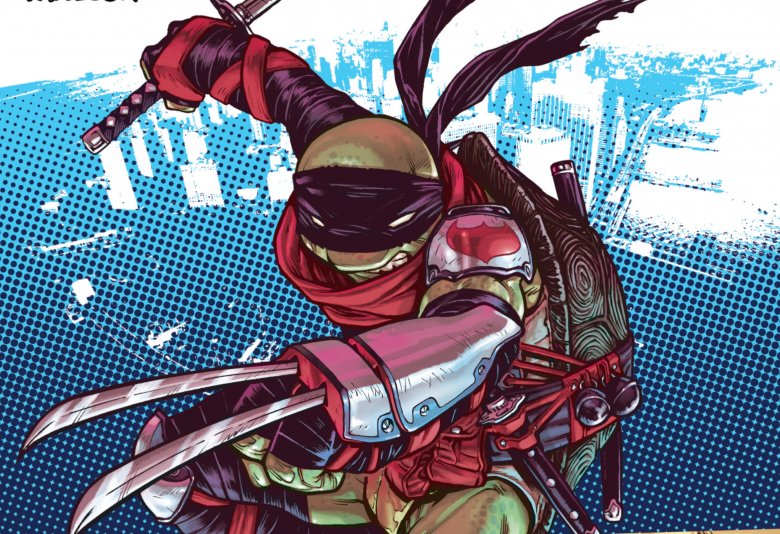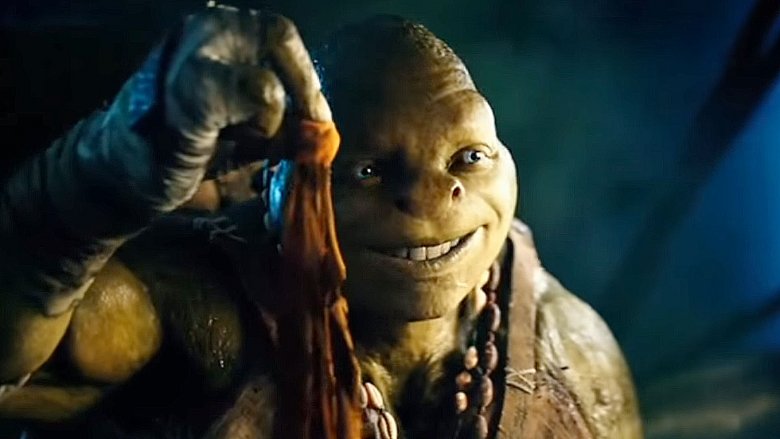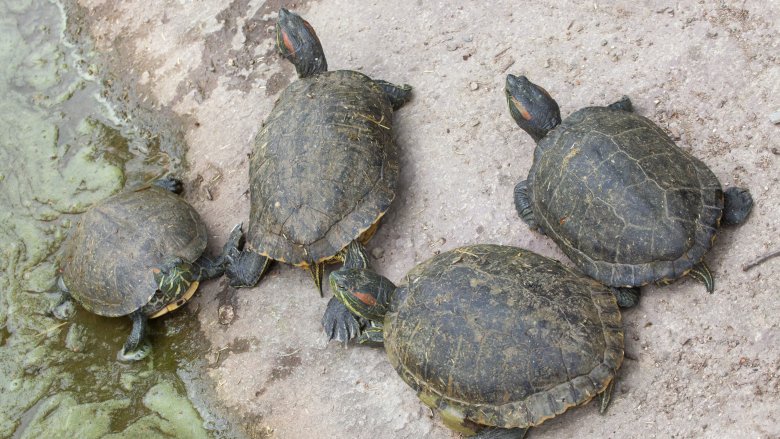The Most Terrible Things The Teenage Mutant Ninja Turtles Have Ever Done
The Teenage Mutant Ninja Turtles are guilty of much, much worse things than crimes against pizza (although we maintain that the Turtles' chocolate fudge, sardine, and whipped cream pie is still one of the worst affronts to mankind ever concocted). With five main comic book series, a number of short and long-running spin-offs, four television series (and a fifth currently in production), six feature films, and more tie-in merchandise than anyone could ever count, Turtle Power has run wild for over 30 years.
With that much material out there, it's no surprise that, occasionally, storytellers have delved into the less savory sides of the Turtles' personalities. Not only do creators have to do something to keep Leo, Raph, Mikey, and Don interesting, but despite their kid-friendly appearance, don't forget that at their core the Turtles are warriors trained by a revenge-bent rodent in an ancient form of warfare, who are forced to live among flowing streams of human waste and have to hide their real faces from the rest of the world. If they're not well-adjusted, who can blame 'em?
They talked Shredder into committing suicide
Despite what you might've heard, the original Teenage Mutant Ninja Turtles comic isn't actually that dark. Yes, the illustrations are black and white, punctuated with heavy inks and a scratchy, underground art style. But Teenage Mutant Ninja Turtles #1 isn't really a street-level crime story. The origin of the radioactive goo that transforms a few turtles into the Turtles—which involves a slapstick sequence with a blind man crossing the street as a truck full of toxic chemicals hurtles towards him—is a Mel Brooksian Daredevil parody. The relationships between the fearsome foursome, particularly Leonardo and Raphael, poke fun at X-Men like Cyclops and Wolverine. Teenage Mutant Ninja Turtles #1 might look grim and gritty, but in reality, the comic is one big joke.
But, as part of the gag, creators Kevin Eastman and Peter Laird cranked Teenage Mutant Ninja Turtles' violence up to 11, making the whole adventure wildly over-the-top. That exaggerated savagery extends to the Turtles themselves, too. The Teenage Mutant Ninja Turtles aren't superheroes. They're assassins who have been trained by their master to take down one specific target: Oroku Saki, better known as the Shredder.
At the end of Teenage Mutant Ninja Turtles #1, Splinter's adopted sons fulfill their mission: after dispatching Shredder's ninja soldiers, they take on the big boss himself. One thrust of Leonardo's katana later, and Shredder kneels before them, defeated. That's when Teenage Mutant Ninja Turtles' darkness reveals itself for the first time: as Shredder bleeds out, Leonardo offers him a sword, telling his defeated nemesis to kill himself before the Turtles take care of it for him. Shredder decides to take the Turtles out with him—but before he can unpin a hand grenade, Donatello knocks him off of the roof with his bo staff, sending Shredder plummeting to his demise. It's not exactly Casey Jones nonchalantly crushing Shredder's head with a garbage compactor, but it is a spectacularly cold-blooded moment, especially for a quartet of supposed heroes.
Raphael tried to bash Michelangelo's head in
In the cartoons, Raphael is cool, rude, and mostly harmless. In the comic books, he's a borderline psychopath. For example, in Eastman and Laird's Raphael #1, one of the one-shot "micro-series" produced early in the Turtles' run (and, notably, the comic that introduced the Turtles' ally Casey Jones to the world) Raphael loses his temper during a routine training session and tries to brain Michelangelo with a wrench.
There's no mistaking Raphael's intent, either. After Michelangelo counters every attack that Raphael throws his way—and punctuates his victory with a little bit of good-natured trash talk—Raph goes into a berserker rage, destroying furniture and screaming about how Mikey cheated. Leonardo and Donatello stop Raphael before he brings the wrench down on Michelangelo's head, and when he snaps out of it, Raphael is visibly shaken.
As he takes to the New York City rooftops to clear his head, Raphael reflects on his experience. "What happened to me back there?" he wonders. "Seemed like everything went blank—all I could feel was intense anger!" And if that's not clear enough, he continues: "Sometimes in a fight—even just sparring—I want to kill. Am I crazy?"
Yes, Raphael. The answer is yes.
Casey Jones killed a teenager and went on a drunken rampage
Casey Jones isn't a teenager, a mutant, a ninja, or a turtle, but he is 100 percent a key member of the Teenage Mutant Ninja Turtles' team. Aside from April O'Neil, no other human being has spent as much time with the heroes in a half-shell, and no one else knows as many of their secrets.
And so, when Casey Jones does something terrible, it's just as memorable as an infraction by one of the Turtles themselves. Casey isn't exactly stable—if you strap on a hockey mask and fight crime with baseball bats and golf clubs, you're definitely not all there—but in Teenage Mutant Ninja Turtles #48, things get especially bad for the sports-themed vigilante. During a training exercise, Casey is mugged by a group of knife-wielding teenagers, and he defends himself with one of his signature hockey sticks. Unfortunately, Casey hits one of the attackers too hard, and the kid falls to the ground dead.
Unlike the Turtles, Casey wasn't raised to be an assassin, and the teen's death—even though it was an act of self-defense—hits Mr. Jones particularly hard. In Teenage Mutant Ninja Turtles #49, which takes place about a week later, Casey spends the first half of the issue alternately drinking and throwing up. When that doesn't soothe his troubled soul, Casey heads out into the woods, where he finds Donatello contemplating a stream. Of all of the Turtles, Casey knows Donatello the least, and that makes him the perfect outlet for Casey's anger. Casey challenges Donatello to a fight, and makes fun of Donny when the Turtle refuses to accept. Exasperated, Donatello gives in and promptly kicks Casey's butt, straining their relationship even further but giving Casey the insight he needs to forgive himself and move on—eventually.
Everything that happens in Bodycount
Technically, Bodycount is a Teenage Mutant Ninja Turtle comic. It's plotted and co-drawn by Turtles creator Kevin Eastman, and stars Raphael and Casey Jones. Bodycount doesn't feel much like a Teenage Mutant Ninja Turtles comic, however. Not only does the plot borrow more from John Woo's Hong Kong action flicks than Bronze Age Marvel Comics and classic science fiction, but if it doesn't set the record for the most head shots per panel in a comic book, it's got to be awfully close.
In Bodycount, Casey and Raph team up to assist a former mob associate named Midnight escape murder at the hands of her former employers (although, given that Midnight mows down dozens and dozens of people over Bodycount's four issues, it's not clear why she needs their help). Whatever Midnight's crimes are, Casey Jones is willing to overlook them because Midnight is cute—and that's just the first line that Raphael and Casey cross as Bodycount rolls on. In Bodycount, Raphael trades his sais for a micro-SMG. At one point, Raphael kills a mobster and uses his body as a shield. He drops a hand grenade into a hot dog cart and turns it into a rolling, mobile bomb. Casey sticks to his code a little bit better—throughout the mini-series, he constantly reminds Raphael how much he hates guns—but Casey doesn't bat an eye when Midnight shoots a man's head clean off his shoulders, and doesn't seem to mind when Raphael charges into battle wielding a shotgun painted like a shark.
And what do Raphael and Casey get for their trouble? Not much, other than the thrill of brutally dismembering an entire army of Chinese gangsters. A limited-edition Wayne Gretzky hockey puck saves Casey from a wayward bullet, while Midnight and Casey share a passionate kiss—you know it's passionate because letterer Steve Lavigne decided to accent the moment with a "SLURP" sound effect—and then head back to New York, where the entire adventure is never referenced ever again.
Michelangelo almost sacrificed a stray cat in a black magic ritual
Michelangelo's pet cat, Klunk, raises a number of ethical questions—mainly, why is it okay for a group of animals, who originated as pets themselves, to keep other animals captive? Tales of the TMNT #9 doesn't address that issue, instead telling a heartfelt story about Klunk while proving that Michelangelo is the worst pet owner of all time.
As "The Path" begins, Michelangelo broods on the Ninja Turtles' couch, and can't be bothered to get up when Klunk sneaks out of an open window. It's a fatal mistake. Klunk wanders into the road and is hit by a car. Distraught—but still ignoring the fact that this is his fault—Michelangelo hears the accident and rushes outside, where he finds Klunk in the care of an old bag lady. The woman tells Mikey that Klunk doesn't have long to live, but knows someone who might be able to help.
That turns out to be Thomas, a witch doctor who lives in a shack by the river. Thomas offers Michelangelo a choice: either he can let Klunk die, or he can sacrifice a life of equal value in order to save Klunk. No problem, Mikey thinks. All he has to do is find another cat and trade it in for Klunk. That's easier said than done. Michelangelo retrieves a stray kitten from the alleyway behind the Turtles' abode—something no one would miss, Mikey argues—and brings her to Thomas as a sacrifice.
However, just before Thomas pulls the metaphysical trigger, Michelangelo changes his mind. Klunk dies thanks to Michelangelo's negligence, and the young Turtle returns home, where he discovers that the stray is from a litter of Klunk's babies—and where Splinter gives Mikey a pep talk that makes his student feel even worse. If Michelangelo is bad at taking care of other animals, at least he comes by it honestly.
Leonardo joined the Foot Clan as Shredder's apprentice
IDW's Teenage Mutant Ninja Turtles comic only features input from one of the Turtles' creators—Kevin Eastman helps plot the series, while Peter Laird washed his hands of everything teenage, mutant, and ninja after he sold the franchise to Viacom and Nickelodeon in 2009—but for many fans, the comic feels like a long-awaited return to form. That's especially true of IDW's "City Fall" storyline, an eight issue epic that chronicles the Foot Clan's ascent to New York City's number one gang, with the Turtles' former leader, Leonardo, serving as Shredder's right hand man.
In Teenage Mutant Ninja Turtles #22, Foot Clan soldiers ambush Casey Jones, and the Turtles rush to their friend's aid. In the ensuing melee, Casey is mortally wounded, and Leonardo disappears. With Casey hovering near death, the remaining Turtles must abandon their brother in order to take Casey to the hospital—and that's where the trouble begins. As doctors operate on Casey, a Japanese witch and long-time Foot Clan ally named Kitsune casts a spell on Leonardo, corrupting his memories and making him think that the Shredder, not Splinter, is his true master.
When the Ninja Turtles invade the Foot Clan's headquarters, Leonardo disavows his former family, casts aside his blue mask in favor of some Foot Clan apparel, and proceeds to wipe the floor with his brothers. They don't take it well. As Leonardo leads the Foot Clan on a war against New York's other gangs, Raphael goes on a rampage throughout the city. Meanwhile, the Foot Clan conquers New York City, and while Leonardo still refuses to kill—the brainwashing isn't that complete—he has no reservations about capturing other gang leaders, delivering them the Shredder, and standing by while Oroku Saki chops their heads off.
The heroes regroup and attack the Foot Clan again, and surprisingly it's Raphael—who is both Leonardo's biggest rival and the Turtle who knows Leo the best—who is able to talk his brother down. Still, the damage is done: as the Turtles flee, Leonardo is stuck in a confused daze, and the Foot Clan reigns supreme over New York's criminal underworld.
Michelangelo sexually harassed April O'Neil
It shouldn't be much of a surprise that April O'Neil is the target of some verbal harassment in the 2014 Teenage Mutant Ninja Turtles reboot. Megan Fox, who plays April in the revamp, famously left the Transformers franchise because of Teenage Mutant Ninja Turtles producer Michael Bay's sexist attitude towards women. That doesn't make the Turtles' attitude towards April feel any less icky, however, especially when the worst offenses come from Michelangelo, who normally serves as the Turtles' comedic relief.
In Teenage Mutant Ninja Turtles, Mikey's verbal abuse is absolutely constant, too. The first time that the Turtles and April meet, April lies prone at their feet, terrified out of her mind, while Michelangelo quips, "She's so hot! I can feel my shell tightening!" After April passes out with shock—ostensibly because the Turtles are frightening, although in reality she probably just doesn't want to put up with Mikey's come-ons—she wakes up on a mysterious bed, while Michelangelo calls her the "hot chick," promises her that they're capable of having "adult conversations," jokes about hooking up with April's "hot friends," threatens her, and then brags that he talked with "a girl" while she's still in earshot.
Oh, and all of that takes just over four minutes. Teenage Mutant Ninja Turtles is 101 minutes long—and trust us, it doesn't get any better.
They caused an ecological disaster
Britain has always had a fraught relationship with the Teenage Mutant Ninja Turtles. In the '80s and '90s, the animated series was called Teenage Mutant Hero Turtles in the United Kingdom—allegedly, the word "ninja" was considered too violent for a children's cartoon. Similarly, since nunchucks are illegal in UK, British authorities recut the Teenage Mutant Ninja Turtles animated series and its live-action feature film spin-offs in order to eliminate Michelangelo's signature weapon (in later seasons of the cartoon, Michelangelo started using a shell-shaped grappling hook instead, in order to make things easier on overseas distribution companies).
But not all of the problems that the Turtles created unfolded on-screen. Even without nunchucks, British kids knew a good thing when they saw one, and before long little boys and girls around the United Kingdom were asking for a little Raphael, Michelangelo, Donatello, or Leonardo of their own. Thanks to the popularity of Teenage Mutant Hero Turtles, around 250,000 red-eared terrapins—which are the easiest type of pet turtle to care for, but happen to be native to North America—entered the region in the early '90s (by contrast, in the late '80s, only about 33,000 red-eared terrapins made their way across the pond). That's when the trouble started.
Baby terrapins are easy to take care of. Adult terrapins require special equipment and a lot of upkeep. As British children grew out of the Hero Turtles and started to ignore their pets, busy parents decided that it would be easier to release the terrapins into the wild than continue to care for them. Unfortunately, introducing a non-native species into a carefully balanced ecosystem rarely works out well, and before long the terrapins were causing havoc, munching on baby ducks and other reptiles.
While the terrapin situation has gotten better thanks to a few conservation groups, the problem still persists—at least for now. As environmentalists note, if one more wave of Turtle fever grips the country, the terrapin crisis could happen again. In other words, maybe Teenage Mutant Ninja Turtles: Out of the Shadows' "Certified Rotten" 38 percent Rotten Tomatoes score is a blessing in disguise.
